The Building Regulations concerning hearths can be an area of confusion with different thicknesses, materials and terms such as constructional and superimposed to consider. By breaking these regulations down to what is relevant to you, we hope this simple guide clears the mystery surrounding hearths.
Firstly, what is the purpose of a hearth? A hearth provides a clearly defined protective area around and under your stove to prevent it setting fire to the fabric of your home and to prevent people getting too close. For obvious reasons they are constructed from non-combustible materials and must be of suitable dimensions (as dictated by the Building Regulations) to catch any hot ash or sparks that may escape from the fire, thus preventing the risk of fire from combustible material.
Additionally, the decorative hearth serves as a visual warning area, helping to prevent the placement of combustible items near the stove.

Constructional – Traditionally, stoves were only installed in existing fireplaces and sat on what is known as a constructional hearth. The term ‘constructional’ simply means it is built into the floor or is part of the construction of the building. This is probably still the most common type of hearth in UK homes and there are three measurements to consider:
- At least 150mm (6”) of hearth either side of the stove
- At least 300mm (12”) of hearth in front of the stove (technically, the regulation is 9” but the majority of manufacturers require 12”)
- If the floor is combustible then the hearth must be at least 250mm* (10”) deep OR this can be reduced to 125mm (5”) deep if you have an air space or air gap of 50mm underneath
Understanding Hearth Requirements and Safety
When installing a hearth, it’s essential to consider not only the constructional aspects but also the safety implications. The hearth serves as a barrier between the stove and combustible materials, reducing the risk of fires. A solid concrete floor can serve as a suitable constructional hearth if it meets specific thickness requirements. Approved Document J provides detailed guidance on hearth dimensions and materials, emphasizing the importance of non-combustible materials and adequate clearance from the stove to prevent accidents.
Using non-combustible material for hearths is crucial to ensure safety and compliance with building regulations.
In addition to the physical dimensions, the hearth must be clearly marked to warn occupants of the potential dangers of heat and sparks. This marking helps prevent the placement of combustible items near the stove, ensuring a safe environment for both the occupants and the structure of the building.
Even if a room has a wooden floor, specific areas, particularly where stoves are installed, must be made of non-combustible materials like concrete to prevent fire hazards.
The measurement of 250mm may seem big however, bear in mind this is a constructional hearth and so some of this is built down into the structure of the floor:
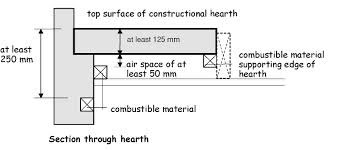
Cool Hearth Rated – These are the exception to the rule. Some modern stoves do not exceed 100oC at their base and have received a cool hearth rating**.
** These are the only models of stove suitable for 12mm superimposed hearths) which are typically manufactured from glass, slate, granite or sandstone for their decorative as well as protective qualities. But do bear in mind, the stove must be officially tested and certified as Cool Hearth rated. Simply having a log store beneath or not running it particularly hot does not count.
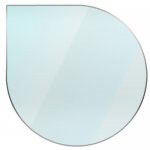
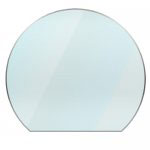
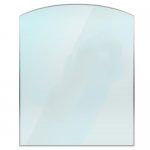
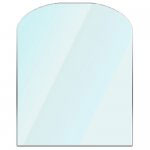
Free Standing Hearth – Contemporary convection stoves can be positioned anywhere in the room but still require a hearth. These would be of the superimposed variety described above but the regulation here is they must measure at least 840mm by 840mm. Please click here to view our Hearths

What is a Hearth and Why is it Necessary?
A hearth is a non-combustible surface that is designed to protect the surrounding area from heat damage and prevent fires. It is typically made of materials such as concrete, stone, or glass, and is installed beneath a freestanding stove, wood burning stove, or other solid fuel appliance. A hearth is necessary for several reasons:
Solid fuel stoves can be integrated into modern home design, emphasizing the aesthetic benefits of glass hearths as a stylish and safe complement.
- It provides a safe surface for the stove to sit on, preventing heat damage to the surrounding floor or walls.
- It helps to contain sparks and embers, reducing the risk of fires.
- It provides a clear visual warning of the stove’s presence, helping to prevent accidents.
Hearth Regulations for Different Installations
Hearth regulations vary depending on the type of installation, such as freestanding stoves which have specific hearth requirements. Here are some key regulations to consider:
Regulatory considerations are crucial for installations that may transition from using a stove to an open fire. It is important to adhere to stricter guidelines to ensure safety and compliance.
Best Material for Your Hearth
When choosing the best material for your hearth, consider both functionality and aesthetics. Slate hearths are a stylish and versatile option for both traditional and contemporary stoves, offering different color finishes like deep matte grey and polished jet black.
Constructional Hearth for Fireplace Recess
A constructional hearth is a type of hearth that is specifically designed for installation in a fireplace recess. It is typically made of concrete or brick and is designed to provide a safe and heat-resistant surface for the stove to sit on. The regulations for constructional hearths in fireplace recesses are as follows:
- The hearth must be at least 125mm thick.
- The hearth must project at least 500mm into the room.
- The hearth must be wider than the recess by at least 150mm.
For a freestanding stove, the hearth must also meet specific size and thickness requirements, including a minimum thickness of 125mm and a projection of at least 500mm into the room.
Free Standing Stoves and Hearth Requirements
Free standing stoves are stoves that are not installed in a fireplace recess. They require a hearth that is specifically designed for free standing installations. The regulations for free standing stoves and hearths are as follows:
- The hearth must be at least 12mm thick.
- The hearth must be at least 840mm x 840mm in size.
- The hearth must have at least 225mm of clearance in front of the stove door.
- The hearth must have at least 150mm of clearance on either side and at the rear.
Note: These regulations are subject to change, and it is always best to consult with a qualified installer or check with local authorities for the most up-to-date information.
Hearth Material Options
When it comes to choosing the right material for your hearth, there are several options to consider. Each material has its own unique benefits and drawbacks, and the right choice for you will depend on your specific needs and preferences.
Best Material for Your Hearth
Selecting the best material for your hearth involves considering factors such as durability, heat resistance, and aesthetic appeal. Here are some popular options:
- Granite: Known for its durability and heat resistance, granite is an excellent choice for high-traffic areas. Its natural beauty and variety of colors make it a versatile option for different home styles.
- Slate: This dense, non-porous material is highly resistant to heat and moisture, making it ideal for hearths. Slate’s natural texture and rich colors add a rustic charm to any room.
- Glass: For a sleek, modern look, glass hearths are a fantastic option. They are not only stylish but also highly durable and heat-resistant, perfect for contemporary homes with wood burning stoves.
- Concrete: Concrete is a durable and versatile material that can be customized to match your home’s decor. It can be stained or painted, offering a wide range of design possibilities.
Glass Hearth: A Modern Option
Glass hearths have become increasingly popular in modern homes due to their sleek and sophisticated appearance. They offer a contemporary look that complements modern stoves and decor. Besides their aesthetic appeal, glass hearths are highly durable and resistant to heat, making them a practical choice for homes with wood burning stoves. Their transparent nature can also create a sense of space and light in the room, enhancing the overall ambiance.
Ensuring Compliance with Building Regulations
When installing a hearth, ensuring compliance with building regulations is crucial for safety and functionality. Here are some key considerations to keep in mind:
- Constructional Hearth: A constructional hearth is made from non-combustible materials like concrete, brick, or stone. It is designed to protect the floor and surrounding area from heat damage.
- Combustible Materials: Avoid placing combustible materials, such as wood or carpet, near the hearth or stove. These materials can easily catch fire if exposed to high temperatures.
- Non-Combustible Materials: Ideal for hearths and surrounds, non-combustible materials like glass or slate provide both safety and aesthetic appeal.
- Hearth Temperature: The hearth temperature should not exceed 100°C. The hearth should be designed to prevent any combustible materials from catching fire.
- Free Standing Stoves: For free standing stoves, the hearth must be at least 250mm thick and extend at least 500mm outwards into the room. This ensures adequate protection from heat and sparks.
- Fireplace Recess: A fireplace recess requires a constructional hearth that is at least 125mm thick and extends at least 500mm outwards into the room. This provides a safe and heat-resistant surface for the stove.
By adhering to these guidelines and selecting the appropriate material for your hearth, you can ensure compliance with building regulations and create a safe, enjoyable space for your family to gather around the fire.








Hi
Can you tell me if the Oylmpus 10kw requires a constructional hearth or is it ok just with 25mm decorative hearth ?
Thanks very much for your enquiry. I have passed this on to our Customer Services Team who will respond to you directly.
Can you explain what type of constructional hearth is required for an inset stove?
Hi, i am looking at getting a fre standing stove. It is rated so i can use a 12mm hearth. Does the hearth need to be 840 x 840 or just 150mm each side as i have been told different things. Thank you
I want a double fronted open fire, the fire cradle is 55cm x 25cm the hearth will be 90cm wide and 90 cm deep. It will sit upon a brick construction (3 bricks high). The cradle will sit exactly in the middle.
What thickness hearth would I require please?
Regretably, as we primarily deal with closed heating appliances and their requirements, this is not something that we would be able to answer. I feel your best option for the most accurate advice would be to contact info@hetas.co.uk – http://www.hetas.co.uk and they should be able to provide the answers to your questions.
I was looking to purchase the FLAVEL ARUNDEL 4.9KW DEFRA MULTIFUEL STOVE but don’t know what Hearth I need to build for it? Works are underway on my house and tiles are ready (obviously will use fireproof cement!) but it’s a Victorian house with a shallow fireplace void and original wooden flooring. I know I need to raise up from floor level before tiling, but unsure how much.
Thank you!
A stove such as the incredibly popular Flavel Arundel has not been ‘Cool Hearth rated’ meaning it must be sited on the traditional full-depth hearth (known as a constructional hearth) as opposed to a decorative 12mm hearth (such as only glass or slate for example). We have an article explaining the regulations surrounding hearths (https://www.glowing-embers.co.uk/blog/hearth-regulations/) but basically it can be 125mm deep only if there is a 50mm air gap beneath that. Otherwise, it must be 250mm full depth.
Thank you so much for the swift reply!
Ideally we’d just raise up from wooden floor and then use heatproof cement to apply the zellige tiles we plan to use. We do not need a very big stove at all, and our fireplace void is quite shallow, so the stove will project into the room. Do you have a stove you sell and that you would recommend that may fit, and be able to sit on such a hearth? (We live in Zone 2, London).
Thanks again,
B
Hi, Im looking at your smaller sized log burners, however will need to get a new hearth. Am I able to install a hearth so thats its flush with the flooring? My floor is wooden floorboards with a wood tiles.
Thanks
Ted
Unfortunately you would be (or should be) unable to install a hearth that is flush with the floor as besides from being a non-combustible plate for your burner to sit on, one of the primary purposes of the hearth is to designate a clear, raised, safe area around the burner.
Hi, I have read your blog and am more confused, can you help please? I am looking to buy either a Loft or Huntington balanced flue gas stove. Your site says I need to install a 5″ thick hearth underneath. Another stockist told me its 2.5″ and another stockist told me I don’t need to have one at all. So who is right? Thanks in advance.
The hearth regulations within this article are concerned with solid fuel stoves only which burn at far higher temperatures than gas stoves. For the regulations concerning installing gas burners, please seek the advice of a Gas Safe registered engineer.
Hello,
This may sound silly but we urgently need a new fireplace as we are not able to replace our bricks inside the fire box as they don’t make them anymore. Our hearth is raised about 20cm off the ground, it currently does not fit with any fireplace out there to be acceptable with the measurements most fireplaces need from the door to the edge of the hearth. My question is, are we able to get a steel floor tile to screw down into the floor below the current hearth but flush up hard against it to get to the acceptable measurements to fit a new fireplace? Or do we need to take the current one out to put a new one in?
Thank you
Hard to say I’m afraid as in theory that would work as you are extending a non-combustible base to the required distance in front of a bunrer but there are depths that need to be considered also, which are probably more important than the forward distance. I would strongly advise asking a local HETAS installer to conduct a survey at your property who will be able to answer this and any other questions you may have. I will advise however, moving forward, opting for a cool hearth rated stove if the size of the hearth may cause an issue. You can then sit the stove on a decorative hearth. Options we stock are glass, granite or sandstone https://www.glowing-embers.co.uk/fireplaces/hearths